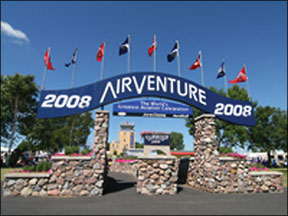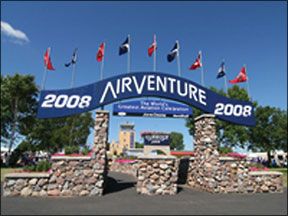Another EAA AirVenture Oshkosh is in the can, and writing this is one of my first considered actions since returning home and putting the airplane away late last night. Many attendees are saying the 2008 edition was one of the best ever, if not number one. The weather was magnificent, with no rain at the site, there were just enough new aircraft and gadgets to keep things interesting and most people seemed to be in a good mood.

288
Perhaps one of the reasons this years event was so good has to do with their (and my) expectations. Through no fault of their own, the Experimental Aircraft Association (EAA) spent the several weeks leading up to the event fending off gloom and doom predictions centered on the price of aviation fuel and general economic conditions. Theres no way, many observers said, for this years show to be as well-attended as previous ones. Notably, the associations staff took a “wait and see” attitude.
Acknowledging the doomsayers, EAA President Tom Poberezny wrapped up the week thusly: “This years convention exceeded my expectations, considering the high fuel prices and a struggling economy,” he said. “But the number of people attending looks to be on a par with last year, and we had more aircraft, showplanes, visiting aircraft.
“Yes, its been a tough year economically for aviation, but this event is the shot in the arm aviation needed. Exhibitors report brisk sales, and the programs offered were the deepest and broadest ever.”
Yes, the success of this years event may have had something to do with lowered expectations. Many exhibitors with whom I spoke expressed surprise that, while overall traffic numbers might have been down-something few would concede-the overall quality of those attendees was up. In other words, the tire-kickers didnt attend. Those who did were not only confident about the industrys future, they were voting with their wallet.
All we know is we cant wait for next year.
Getting There And Back
Despite high fuel prices, I flew myself there and back, requiring four legs totalling around 14 hours total for the round trip. With two exceptions, everything went smoothly, ATC was cooperative and helpful, and the airplane performed as Walter Beech intended. Curiously, both exceptions occurred in Indiana.
One of them involved a super-cheap gas stop, which I was never able to use. To break up the trip to OSH, my passenger and I opted to stop in Kentucky, about halfway there. On the trip back, I was letting down when ATC informed me my intended fuel stop had exhausted their 100LL supply. I went to Plan B and topped off at another nearby airport, still spending way less than the price at OSH. In that instance, ATC was extremely helpful and even knew the fuel price at the Plan B airport.
The other exception involved the Indianapolis Tracon. Transiting the facilitys airspace on both trips brought attempts to give me a vector or an altitude restriction. There was only one problem: Both times, I was VFR well outside their

288
Class C airspace and hadnt requested any such thing.
The facility seems to be in the habit of giving such “service” to VFR aircraft operating in Class E airspace. I can do without all that “help.” Thanks, anyway.
Blue Button
In last months issue, Tom Turner wrote about backup systems, noting the pilot is the ultimate such device. Tom also discussed certain features of Cirrus Designs newest avionics suite, an upgraded Garmin 1000 dubbed “Perspective.” One of its features is a small blue button on the center console, grouped with the autopilot controls. Labeled “LVL,” pushing the button in any flight mode, even if the autopilot is disengaged, returns the aircraft to straight-and-level flight. During AirVenture, I snagged a demo ride in a new Cirrus SR22 so equipped and can confirm the feature works as advertised.
From a 3500-foot cruising altitude (ground elevation was approximately 750 feet), I reduced power to about 22 inches, letting the SR22 stabilize itself. I then rolled into a 45-degree bank and let the nose fall through, simulating entry into a steep spiral. As airspeed built, I let go of the sidestick and pressed the blue button.
Nothing much happened at first, but the wings leveled themselves and the nose started to come up, slowly. The PFD in front of me turned red as we descended; an alarmed female voice warned, “Terrain, pull up,” or something similar.
Soon, our SR22 was scooting along straight and level, having fully recovered itself and without shedding any parts, large or small. Neither of us had touched a control; the power stayed right where I left it.
In fact, I had steeled myself for some extra Gs, noting any recovery I attempted certainly would generate them. In the event, the autopilot flew smoothly and generated very little more than 1G while recovering. “That was a little aggressive,” my demo pilot remarked. But the airplane did well, and Cirrus little blue button works.
Meanwhile
A lot of other news came out of this years AirVenture, from items like Vern Raburns abrupt role change at Eclipse, a new deal between Mooney and Rolls-Royce to at least hang a turbine engine on an airframe, innovative airframe and powerplant designs, and the proliferation of light sport aircraft.
Separately, the airlines continuing woes, high fuel prices and the general economic condition were on many minds. Most we spoke with expressed determination to keep flying and innovate our way out of any fuel or economic crises, while constantly improving safety. And thats the way it should be.
– Jeb Burnside




